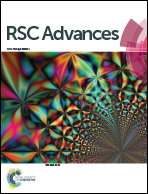Investigation of a sensing approach based on a rapid reduction of azide to selectively measure bioavailability of H2S†
Abstract
A new reaction-based sensor (AHS) was synthesized for quantitative detection of H2S. AHS showed a high selectivity and sensitivity toward H2S over other thio-containing molecules, or reducing reagents with high abundance in living cells. In the presence of H2S, significant fluorescence enhancement (17-fold) was observed due to the reduction of the azide on AHS. The absorption (362 nm) and fluorescence emission (557 nm) of reduced AHS showed a highly linear correlation to H2S level, which were used to measure concentration of H2S in the range of 0–100 μM.



 Please wait while we load your content...
Please wait while we load your content...